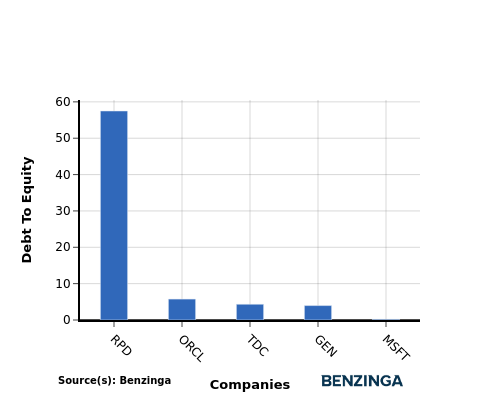Market Analysis: Microsoft And Competitors In Software Industry
Amidst the fast-paced and highly competitive business environment of today, conducting comprehensive company analysis is essential for investors and industry enthusiasts. In this article, we will delve into an extensive industry comparison, evaluating
Microsoft Background
| Company | P/E | P/B | P/S | ROE | EBITDA (in billions) | Gross Profit (in billions) | Revenue Growth |
|---|---|---|---|---|---|---|---|
| 29 | 8.84 | 10.27 | 8.17% | 12.27% | |||
| Oracle Corp | 30.11 | 21.50 | 6.57 | 19.27% | 6.4% | ||
| ServiceNow Inc | 105.50 | 15.51 | 13.69 | 4.06% | 21.34% | ||
| Palo Alto Networks Inc | 86.76 | 15.95 | 12.70 | 4.35% | 14.29% | ||
| Fortinet Inc | 37.48 | 43.61 | 10.98 | 43.82% | 17.31% | ||
| Gen Digital Inc | 23.32 | 6.82 | 3.82 | 7.48% | 4.01% | ||
| Monday.Com Ltd | 351.24 | 10.73 | 11.74 | 2.3% | 32.29% | ||
| Dolby Laboratories Inc | 26.85 | 2.79 | 5.36 | 2.72% | 13.13% | ||
| CommVault Systems Inc | 36.61 | 21.26 | 6.66 | 3.9% | 21.13% | ||
| Qualys Inc | 25.47 | 9.06 | 7.28 | 9.49% | 10.11% | ||
| SolarWinds Corp | 28.70 | 2.27 | 4.02 | 5.26% | 6.14% | ||
| Progress Software Corp | 44.22 | 5.60 | 3.09 | 2.51% | 28.88% | ||
| Teradata Corp | 17.01 | 14.25 | 1.11 | 19.38% | -10.5% | ||
| Rapid7 Inc | 59.10 | 85.38 | 1.77 | -25.97% | 5.36% | ||
| Average | 67.11 | 19.59 | 6.83 | 7.58% | 13.07% |
By conducting a comprehensive analysis of
-
The stock's Price to Earnings ratio of 29.0 is lower than the industry average by 0.43x, suggesting potential value in the eyes of market participants.
-
Considering a Price to Book ratio of 8.84, which is well below the industry average by 0.45x, the stock may be undervalued based on its book value compared to its peers.
-
With a relatively high Price to Sales ratio of 10.27, which is 1.5x the industry average, the stock might be considered overvalued based on sales performance.
-
The Return on Equity (ROE) of 8.17% is 0.59% above the industry average, highlighting efficient use of equity to generate profits.
-
Compared to its industry, the company has higher Earnings Before Interest, Taxes, Depreciation, and Amortization (EBITDA) of
$36.79 Billion , which is 56.6x above the industry average, indicating stronger profitability and robust cash flow generation. -
The company has higher gross profit of
$47.83 Billion , which indicates 35.17x above the industry average, indicating stronger profitability and higher earnings from its core operations. -
The company is witnessing a substantial decline in revenue growth, with a rate of 12.27% compared to the industry average of 13.07%, which indicates a challenging sales environment.
Debt To Equity Ratio

The debt-to-equity (D/E) ratio is an important measure to assess the financial structure and risk profile of a company.
Considering the debt-to-equity ratio in industry comparisons allows for a concise evaluation of a company's financial health and risk profile, aiding in informed decision-making.
When comparing
-
In terms of the debt-to-equity ratio,
Microsoft ( MSFT ) has a lower level of debt compared to its top 4 peers, indicating a stronger financial position. -
This implies that the company relies less on debt financing and has a more favorable balance between debt and equity with a lower debt-to-equity ratio of 0.21.
Key Takeaways
For
This article was generated by Benzinga's automated content engine and reviewed by an editor.
Related News
-
Trump says chips from China will face national security probe; further tariffs expected
Reuters - 5:53 PM ET 4/13/2025
-
Trump says chips from China will face national security probe; further tariffs expected
Reuters - 1:02 PM ET 4/13/2025
-
Trump plans separate levy on exempted electronics amid trade war, Lutnick says
Reuters - 12:57 PM ET 4/13/2025
-
U.S. Tariff Exemptions for Electronics Are âTemporary,â Says Commerce Secretary
Coindesk - 11:10 AM ET 4/13/2025
-
US Commerce Secretary says exempted electronic products to come under separate tariffs
Reuters - 9:24 AM ET 4/13/2025
-
US Commerce Secretary says exempted electronic products to come under separate tariffs
Reuters - 9:24 AM ET 4/13/2025
-
Trump spares smartphones, computers, other electronics from China tariffs
Reuters - 11:38 PM ET 4/12/2025






